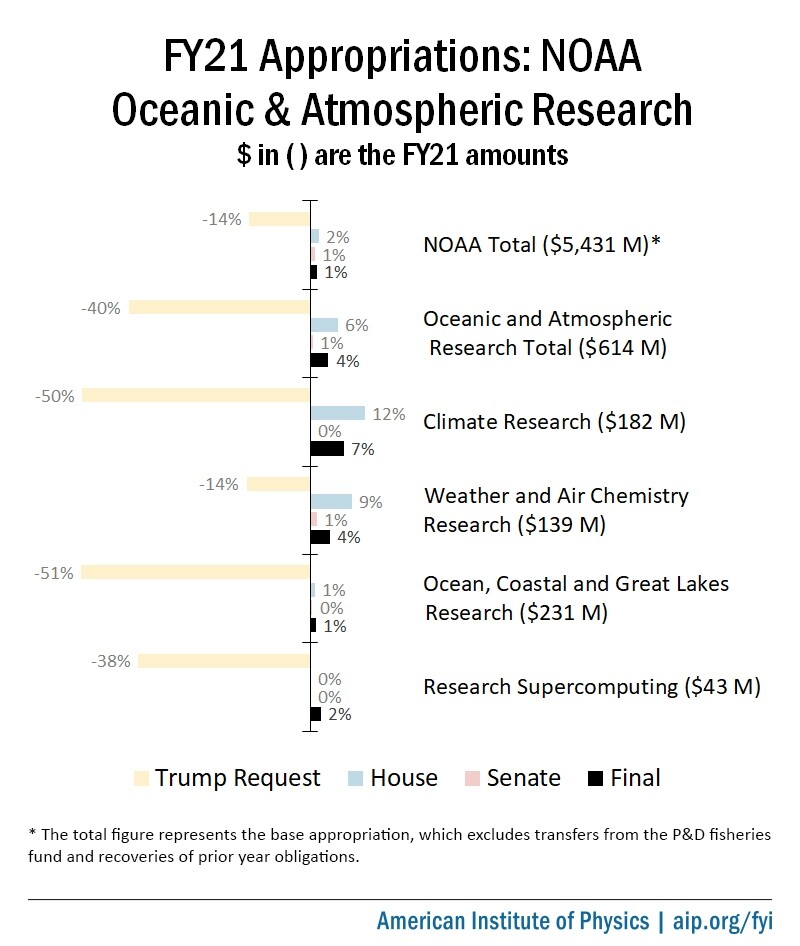
Final FY21 Appropriations: National Oceanic and Atmospheric Administration
In its fiscal year 2021 appropriations legislation
An explanatory statement


Oceanic and atmospheric research
The budget of NOAA’s Office of Oceanic and Atmospheric Research is increasing 4% to $614 million. The office supports a broad portfolio of in-house and extramural research on weather and climate modeling, coastal resilience, and ocean exploration, among other areas. Most of the additional funding is directed toward climate and weather research activities.
Climate research. Funding for climate research across NOAA’s labs and cooperative institutes is increasing by $9 million to $76 million, and the budget for the Climate Competitive Research grant program is increasing by $1 million to $64 million, rejecting the Trump administration’s proposal to defund the program.
NOAA is directed to spend $9 million on studies of “stratospheric conditions and the Earth’s radiation budget,” $5 million more than the amount specified
Congress also provides $43 million for the Regional Climate Data and Information program, a $2.5 million increase. The additional funding is allocated to the Regional Integrated Sciences and Assessments program, which develops decision-support tools for disaster preparedness and city planning, with Congress directing NOAA to expand its geographical coverage.
Congress also encourages NOAA to increase collaboration with the Department of Energy on “climate research and modeling efforts, including, as appropriate, the sharing of resources and the exchange of detailees, in order to minimize the duplication of efforts and to increase the cross pollination of ideas and research.”
Coastal inundation. The House report proposed that the Office of Oceanic and Atmospheric Research “initiate a research agenda to improve understanding of inundation risks to coastal areas as a result of the climate crisis and to meet the information needs of decision-makers as they consider how to appropriately adapt and increase resilience to such impacts.” The final statement stipulates that this be a cross-NOAA effort and directs the agency to consider establishing a Cooperative Institute for Coastal Resilience and Adaptation.
Earth Prediction Innovation Center. Over the past two years, NOAA has worked
Tornado warning program. Via the House report, Congress allocates the $3.2 million requested to create the Tornado Warning Improvement and Extension Program, an effort mandated
Weather research prioritization. As part of its direction for the National Weather Service, Congress instructs NOAA’s science advisory board to publish a report that will support policymakers’ prioritization of investments in weather forecasting, modeling, data assimilation, and supercomputing over the next ten years. The direction replaces a House proposal for NOAA to commission the first-ever decadal survey for the “U.S. weather enterprise.”
Ocean mapping. Congress is increasing the budget for the Ocean Exploration and Research program by $1 million to $43 million and directs NOAA to accelerate mapping of the U.S.’ Exclusive Economic Zone, which was a Trump administration priority
A remotely operated vehicle is recovered after exploring waters off the coast of Florida in November 2019.
(Image credit – NOAA)
Satellite programs
Next-generation satellites. Congress provides the requested amounts for NOAA’s programs to acquire new geostationary and polar-orbiting weather satellites as well as new space weather monitoring capabilities. It also accepts NOAA’s proposal to create a Geostationary Earth Orbit program focused on developing innovative mission concepts for the following generation of satellites. Congress provides the program with initial funding of $10 million, transferred from a separate account, and highlights the potential of Cubesats and low-cost sensors to augment space weather monitoring capabilities. Congress also provides no less than $2.7 million for the recently established Joint Venture Partnership program, which will support collaborative projects with NASA and commercial entities to develop new observational capabilities.
Commercial weather data. Congress directs NOAA to increase funding for the commercial weather data pilot program and an associated commercial data purchase program by at least $4 million, divided between the two activities at the agency’s discretion. NOAA had proposed to ramp up the commercial data purchase program from $5 million to $15 million and the pilot program from $3 million to $8 million.
Office of Space Commerce. Congress accepts the administration’s proposal to create an expanded Office of Space Commerce that will take on a greater role in space traffic management. However, the office will remain
Other items
Scientific integrity policy. Congress states that “many are alarmed” by the findings of an investigation
Education Office. Congress rejects the Trump administration’s proposal to eliminate all major programs in NOAA’s Office of Education and instead increases the office’s budget by $3 million to $33 million. The increase is directed entirely to the José E. Serrano Educational Partnership Program with Minority-Serving Institutions.
Workforce diversity. Congress directs NOAA to “take discrete steps to promote racial and cultural acceptance and diversity within its workforce,” including by reporting on the diversity of its current workforce and its plans to increase the recruitment and retention of employees from diverse backgrounds.




